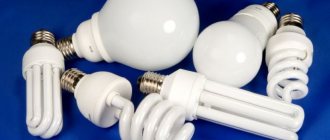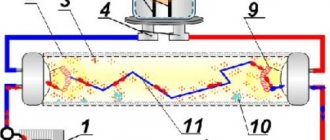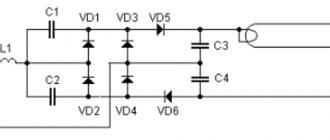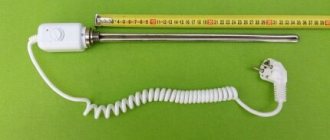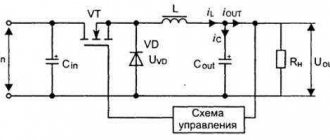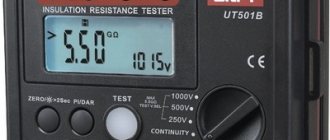Growing demands on modern lighting systems force consumers to look for new technical means to provide such an important function. Some time ago, a transitional stage took place from classic incandescent lamps to mercury and sodium devices. Such devices are still used today in different versions, but their operation is accompanied by significant disadvantages. In particular, mercury lamps have serious restrictions on their use and high requirements for the technical organization of the installation with further maintenance due to the toxicity of the working environment. Sodium models, in turn, are characterized by a skew in the color spectrum of the glow. The induction lamp does not have the two indicated disadvantages, which can easily replace both full-fledged mercury models and sodium-based devices.
Installation of induction lamps
Despite many differences in the immediate operating process, induction devices still belong to the segment of common gas-discharge lamps. The main feature of such lamps is the absence of electrodes. However, this difference is also conditional. The basis of the design is also a flask that contains plasma - it acts as a generator of light energy. In addition, induction lamps are complemented by a gas cylinder, which is located next to the magnetic coil. Such devices are called electrodeless for the reason that direct contact of the working element with the gaseous environment is not provided. Also, the absence of classic metal electrodes inside the cylinder increases the service life of the device. As practice shows, lamps of this type are not recycled until the phosphor resource is used up. This corresponds to approximately 100,000 operating hours of the device.
Efficiency and economy
The main problem with induction lamps is that they are often not available in specialized stores. At home, you can try to make the device yourself. The basis is a fluorescent lamp with a ring-shaped bulb. A winding of eight turns is made directly on it, and then at a right angle of 13 loops around one ferrite part. Then electricity with a power of 2-3 MHz is supplied to the coil.
But the model will have questionable performance, so it is better to purchase a finished product. Usually you have to make advance orders in foreign stores, since induction lamps in the Russian Federation and former Soviet countries have recently appeared on the market. The cost of the devices will pay off in about a year and a half, because the load on the network will be significantly reduced. Even when illuminating a large area, energy costs will be minimal.
Electric induction lamps are necessary for use in open street areas or large industrial premises. These are promising devices that in 5-7 years will be widely used in enterprises.
Operating principle of models with an external generator
All induction lamps work in conjunction with a generator in one way or another. The most common devices are those that are operated with the connection of an external electronic device that generates current at a high frequency. Energy flows through the winding of the coil, which is equipped with an induction lamp, after which the lamp lights up. Gas atoms, excited by electricity, fill the lamp cavity, emitting photons with waves whose length corresponds to the particles of the plasma filling the lamp.
Typically, such lamps contain mixtures including argon and mercury. The first gas is added precisely to simplify ignition at a low temperature. This function is appropriate if the mercury pressure is not enough to generate a discharge that activates induction lamps. The operating principle of such devices is in many ways similar to luminescent devices for the reason that in both cases the possibility of a phosphor is assumed, which ensures the formation of ultraviolet radiation.
Principle of operation
Despite the fact that the basic principle of operation of such systems was invented back in the last century, until recently it was not embodied in lighting devices.
The essence of the operation of such systems is to heat the gases pumped into the flask to the state of plasma. Such high heating is achieved under the influence of magnetic induction - the bulb is braided with a spiral of wires, forming a magnetic field. This produces high intensity light.
Ring device
Since there is no direct contact of gases with the electrodes, the burnout effect is minimal. Thanks to this, such lamps can last about ten years, practically without losing their brightness. By and large, the new induction models are the well-known fluorescent lamps (FL), only improved. They eliminate the main disadvantages of LL: flickering, sensitivity to frequent switching on, rapid resource burnout, instability to voltage surges.
Induction lamp models differ in the location of the ferrite rings - outside on the bulb (external induction) or inside the base and bulb (internal induction).
Lamp device
At the moment they are much less common than LED systems, but many models have already been put into mass production. This means that in the near future they can become real competitors to market leaders. The main limiting factors for their spread is the specific shape of the bulb, for which lampshades and reflectors of standard lamps are not suitable. However, modern compact models are quite suitable for installation in ordinary lamps.
Features of devices with an integrated generator
Lamps operating from an external separate generator are often not supplemented with a phosphor coating. For this reason, they scatter only the light produced by the ionized gaseous plasma. According to the general classification, such models can be classified as gas-light lamps. By the way, street induction lamps are often made exactly according to this principle - with an external location of the electric generator. This is due to the long service life and increased reliability of such devices - accordingly, they are more resistant to damage and other external influences.
Lamp classification
Lamps are classified according to the shape of the bulb, the method of installing the generator and coil. Based on the placement of electromagnets, luminaires are classified as follows:
- internal induction;
- external.
You might be interested in LED strip ceiling for a lighting box
In the first version, the coil and cores are located inside the bulb, and in the second, they are placed around it. Such lamps last much longer, because the electromagnet dissipates light and heat easily and without obstacles. Depending on the installation of ballast, there are :
- with separate generator;
- built-in
Spaced devices are luminaires with externally placed ballast. In the second type, the electric generator and other elements are located in one housing. There are devices with different shapes:
- round;
- spherical;
- ring-shaped;
- U-shaped.
The first models have the highest performance qualities and a wide temperature range. Lighting is distributed evenly thanks to the ring-shaped bulb. The lamps are suitable for round and oval shades. The devices are optimal for use in warehouses, industrial workshops, shopping centers, sports and public rooms.
The spherical ones look like regular incandescent lamps. These lamps can be used in standard sockets. The devices light up instantly, have high performance, but their light is warm and soft. The lamps are suitable for street lamps, industrial premises, floodlights and lighting of hotels, supermarkets and entertainment centers.
The ring-shaped shape implies the location of the bulb, generator and coil in one structure. The lamps start up quickly even in severe frost (down to -35 degrees), the light does not dazzle, it shines softly and diffusely. Suitable for use in private homes, hotels and inns. In U-shaped devices, the generator is located separately, they emit a bright white color and do not flicker. They can be used in commercial and office buildings; they illuminate stadiums, highways, subway tunnels, billboards and displays.
Main characteristics
One of the main characteristics of lighting devices is light output. In this case, the nominal value is about 80 lm/W. Manufacturers also, in some versions, strive to increase the power of lamps, but this affects the reduction of the working life of the devices. By the way, according to manufacturers, the average operating range varies from 80 to 100 thousand hours. In recent years, users themselves have increasingly paid attention to the time delays for turning on and off lighting devices. In this regard, the induction lamp has an advantage even in the environment of gas-discharge analogues. Thus, the time for the lamp to completely cool down after a power outage is only 5 minutes. As for color rendering, induction models correspond in this characteristic to mercury lamps, since they contain almost the same filler.
Advantages of using IL
Electrodeless lamps generate soft light that is comfortable for the eyes. The shades of colors are not distorted.
The brightness of such lamps can be changed within 30-100% using a simple dimmer for devices with incandescent filament.
The content of solid mercury in modern induction lamps is several times lower than in conventional fluorescent gas-filled lamps
Even after 75,000 hours of operation, induction devices maintain a light power level of 80-85% of the original.
Conventional daylight LLs lose up to 55% of their brightness towards the end of their service life. Over time, dark, opaque circles form on their flasks.
Advantages of using electrodeless induction lamps:
- Efficiency 90%;
- service life up to 150,000 hours;
- light output more than 90-160 lm/W;
- optimal conditions for visual perception of objects;
- operating temperature range from -35 °C to +50 °C;
- color rendering coefficient Ra˃80;
- high energy efficiency indicators;
- minimal heating of the flask;
- unlimited number of start/shutdown cycles;
- no pulsation;
- the ability to adjust the intensity of the glow;
- The warranty period is 5 years.
Manufacturers claim that induction light sources have better technical characteristics than LEDs and are several times cheaper. The energy consumption of these types of light bulbs is approximately the same.
Performance properties of induction lamps
Among the operational features, the ability of lamps to dim, that is, change the radiation intensity in a wide spectrum from 30 to 100%, stands out. This opportunity, by the way, expands the options of intelligent control systems that can be applied to the same street devices. This advantage leads to another distinctive feature. The combination of the device with automatic power control systems and an astronomical timer provides the ability to optimally configure the lamp in terms of energy savings. In addition, induction lamps provide an expanded range of color temperatures. The user can choose soft and natural radiation for a living space or cool lighting for outdoor systems. There is also the possibility of automatic configuration in some models.
Areas of application
The high stability of the operating parameters of gas-discharge lamps allows them to be used even in highly specialized fields - for example, in spectrometry, which requires the use of ultraviolet radiation. Induction-type devices are also used in pumping laser systems to excite gas. But most often such models are still used in more familiar conditions. For example, to provide indoor home and outdoor garden lighting. A separate niche is occupied by industrial induction lamps, which are characterized by high power and a longer service life. Such equipment is used to equip street communications, highway tunnels, industrial and warehouse facilities, stadiums and parking lots.
Device marking
The shape and technical features of the lamps are indicated in their markings. The first two letters IL are the designation of the induction lamp, the third characterizes the shape, then the power is described. The minimum and maximum performance are 15 and 500 W, respectively, but there are also more efficient devices for industrial use. The luminaires can be used in devices with sockets of the E40, E27 and E14 series.
Manufacturers have released a line of phytolamps that differ in the shape and color of the stream. These models are designed to illuminate plants at different periods of their life and development. The series is designated by the abbreviation TIL, and the technical characteristics are indicated by two letters:
- FL - used at the initial stage of flowering, they emit a red luminous flux;
- GP and VG models - necessary during vegetative growth, emission color - blue;
- The unique CL series allows you to control the development of the plant; fruits and flowers quickly appear and ripen under the bright red light.
You might be interested in: Twilight light sensors
If TIL series lamps were initially used to improve the growth of a flower or fruit bush, they are used throughout its entire life. But before buying, you need to understand the labeling. For example, TILPfl-100 is a rectangular phytodevice with a power of 100 W, designed to accelerate flowering. And ILK-60 is a round lamp with a capacity of 60 W.
How much does an induction lamp cost?
Technologically, the process of manufacturing induction lamps is quite complex and unsafe if all requirements for organizing production are not met. This determines the narrowness of the segment in which these products are sold, as well as the high cost at which induction lamps are sold. Prices in the initial class vary in the range of 4-5 thousand rubles. This level significantly exceeds the cost of LED models. Even in premium lines, LED lamps for household use are priced at 2-3 thousand rubles.
The price tags for specialized and industrial induction-type devices are also impressive. In particular, ITL induction lamps for outdoor use are available for an average of 10-15 thousand rubles.
Advantages and disadvantages
Like any other devices, induction lamps have their advantages and disadvantages. Among the advantages are:
- release of a clean and bright stream of light;
- high level of efficiency - up to 80−90 lm;
- efficiency - energy consumption is 80% lower than that of conventional incandescent lamps;
- quick start-up without any delays;
- lack of sensitivity to frequent use;
- Possibility of use together with a dimmer;
- significant service life and trouble-free operation - over 60,000 hours;
- minimal waste of brightness regardless of the age of the lamp.
The devices also have a wide power range - from 15 to 500 W for private use and above the maximum for industrial premises. Different models emit a colored glow - red, blue, white. During operation, the lamp body practically does not heat up.
The main disadvantages of the devices:
- release of toxic substances when the flask is damaged due to mercury vapor contained in it;
- The lamp must be disposed of after use;
- large body sizes are not suitable for conventional lampshades;
- electromagnetic radiation disrupts the operation of delicate electronic devices, so lamps are not installed in airports and premises where there are such devices;
- not suitable for rooms with low ceilings, since the source of ultraviolet radiation must rise above people’s heads by at least a meter;
- low strength of the flask.
